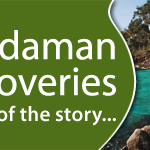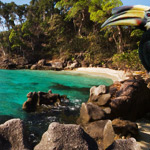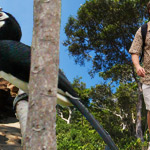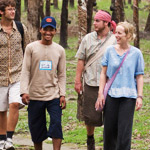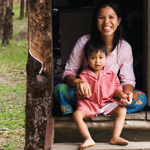Andaman Discoveries Blog
Tuesday, April 12, 2011
Japan Tsunami Support from the children of Ban Talae Nok
This video from the children of Ban Talae Nok, who suffered from Thailand's devastating tsunami in 2004, is dedicated to the tsunami affected children in Japan.
Keep up the good fight!
“Thanks for putting up the video clip for Japan from Ban Talae Nok youth group. It is great, and I sent it to my sister who stays in Japan to help the children in the affected area with her husband. I will be joining them end of this month.” - Mayumi
Labels: Ban Talae Nok, tsunami
Friday, January 29, 2010
Andaman Island Adventure
On Saturday we took a longtail boat out to a series of islands west of the Andaman Coast. This wee island you see above was the first we passed. Little did I know that it would be the beacon of our fate that night...
We reached a small deserted beach in the afternoon and spent the day relaxing. Shell hunting, swimming, and swimming some more. This was a view to the island to the east of us. I cannot explain how beautiful it all was.
At dusk, we headed to the other side of the island to catch the most beautiful sunset over the neighboring island. You could see across this channel to an island that was hard-hit by the tsunami, knocking out an entire portion of mountain as the wall of water washed through the Andaman Sea in 2004.
After the sun went down, we started a bonfire and watched the stars slowly appear. We took a nap until the tide came in, and then headed back to the mainland around midnight. This is the crew to the left: Bodhi, Bow, and Erik.
+me. Very happy.
Unfortunately, we were about half-way home and the rutter broker. Even more unfortunately, all of Bow's friends and family were out fishing for the night, so there were no rescue possibilities.
Labels: North Andaman Region, tsunami
Monday, January 18, 2010
2010 Welcome Message
Dear Friends,
 December 26th marked the five-year anniversary of the tsunami, the catastrophic event that brought the Andaman Discoveries global family together on this mission of compassion. We’re constantly amazed by the degree to which the villagers of the North Andaman have recovered since that life-altering event. A recent example was Children’s Day in Ban Talae Nok...
December 26th marked the five-year anniversary of the tsunami, the catastrophic event that brought the Andaman Discoveries global family together on this mission of compassion. We’re constantly amazed by the degree to which the villagers of the North Andaman have recovered since that life-altering event. A recent example was Children’s Day in Ban Talae Nok...On December 27th we celebrated an afternoon filled with innocent laughter and fun with the villagers. Adults gathered to watch as children played games, sang songs, participated in an eco-quiz, and received gifts courtesy of Andaman Discoveries.
Despite 47 fatalities -- eight of whom were children -- and the physical loss of half their village to the wave, the people of Ban Talae Nok have worked diligently to create a better future for their children. Today, the village is an award-winning model of sustainable development with a highly engaged youth group and a successful responsible tourism program.
The inspiration we draw from such encouraging stories drives our passion to continue this challenging work. Standing together on the threshold of 2010, we can reflect our successes while looking to the challenges ahead. Your continued support and generosity not only motivates us, but makes Andaman Discoveries’ work possible. We look forward to your encouragement and assistance as we face the challenges and accomplishments of a new year. Thank you for being a part of the story.
- The Andaman Discoveries Team
Labels: Ban Talae Nok, Children’s Day, North Andaman Region, responsible tourism, tsunami
Thursday, November 5, 2009
Samoan Tsunami Relief
More Support Needed
 On September 29, a deadly tsunami struck Samoa and American Samoa, wiping out whole villages and sweeping boats inland and cars and people out to sea, and killing scores of people in several islands. The same devastating phenomenon five years ago in the North Andaman region spawned the work of Andaman Discoveries, and so we are keen to help.
On September 29, a deadly tsunami struck Samoa and American Samoa, wiping out whole villages and sweeping boats inland and cars and people out to sea, and killing scores of people in several islands. The same devastating phenomenon five years ago in the North Andaman region spawned the work of Andaman Discoveries, and so we are keen to help.Our friends at Seacology are raising funds to help recovery in the local villages where they have projects. Susan Racanelli, Seacology Development Director, reports:
(Read Susan's full account: Part 1 and Part 2.)
With the proceeds of the Samoa Emergency Relief Fund, we will assist the islanders with the projects they have identified are most necessary. Those villages are: Satapuala village, Upolu Island; and Falealupo and Tafua villages, Savai’i Island. We are anticipating that all of the villages will need repairs to public facilities and basic infrastructure. Seacology has chosen to target three villages where locally-based volunteers live and work, and can monitor the relief effort. Seacology ensures that all money raised will go directly to assist victims of this devastating tsunami.
To donate now, please visit www.seacology.org/news/display.cfm?id=4190
For the Indonesian tsunami of 2005, four of our projects and the villages surrounding them were hit. Of course, it was different for each village, and thus we will have Cedric, our field representative, ask the Samoan villages what they need. In general, the islanders and field representative feel that additional funds should go to help the poorest families and restore infrastructure. Seacology is a nonprofit that partners with island communities to preserve threatened environments, species, and historic cultures; and has been working in Samoa for nearly 20 years.
Labels: disaster relief, Samoa, Samoan tsunami, tsunami
Friday, July 3, 2009
Erik's Adventures - Mangrove Planting in Tung Dap
 From Tung La Ong pier, the departure point from the mainland, the light of dawn shimmered off the dense mist draped over the distant mountains, coating the rainforest with what looked like a rippled layer of icing. Two festively-painted fishing boats idled nearby while women perfunctorily sorted the previous night’s catch. Here I met Nu, my boat driver, a quiet but amiable young man with a shock of jet-black hair that he wears in the rough-cut mullet style currently in vogue in Thai pop culture. With a vigorous crank, our traditional longtail’s engine came to life in a piercing fit, and soon Nu was expertly ferrying us over the tranquil waters of the Andaman Sea towards the southwestern tip of Koh Phratong, home of the fishing village of Tung Dap.
From Tung La Ong pier, the departure point from the mainland, the light of dawn shimmered off the dense mist draped over the distant mountains, coating the rainforest with what looked like a rippled layer of icing. Two festively-painted fishing boats idled nearby while women perfunctorily sorted the previous night’s catch. Here I met Nu, my boat driver, a quiet but amiable young man with a shock of jet-black hair that he wears in the rough-cut mullet style currently in vogue in Thai pop culture. With a vigorous crank, our traditional longtail’s engine came to life in a piercing fit, and soon Nu was expertly ferrying us over the tranquil waters of the Andaman Sea towards the southwestern tip of Koh Phratong, home of the fishing village of Tung Dap.Tung Dap was almost wholly leveled by the tsunami of December 2004, and particularly hard hit were its mangrove swamps. Although the village has since been rebuilt and life has largely returned to normal there, the work of restoring the mangroves, a vital coastal buffer and ecosystem, continues.
We moored the boat just offshore and set upon our first task: retrieving several canvas sacks of mangrove seedlings. With the help of Nu I’d soon added useful new lexis to my budding Thai language skills: nok maak, which means very heavy! Indeed, gravity seemed to increase by an order of magnitude as we plodded through the fine, sediment-rich mud, and before it occurred to me to remove them, the sucking vacuum of each footstep simultaneously claimed both of my 35-Baht flip-flops.
 From there Nu piloted the boat to Tung Dap pier, where we were joined by his wife Pin, as well as Yui and Fen, who’d prepared a savory breakfast of squid in chili sauce, pickled eggs, and fresh vegetables accompanied by white rice -- the foundation of any Thai meal.
From there Nu piloted the boat to Tung Dap pier, where we were joined by his wife Pin, as well as Yui and Fen, who’d prepared a savory breakfast of squid in chili sauce, pickled eggs, and fresh vegetables accompanied by white rice -- the foundation of any Thai meal.With our team now assembled and sated, we leisurely reboarded the longtail and headed inland, navigating our way along a meandering river channel. More than two years after the tsunami, the evidence of destruction is still readily apparent here, with large swaths of denuded land still bearing testament to the wave’s destructive power.
Mangrove seedlings look a bit like unburned candles, varying in length from a few inches to over a foot, and ranging in hues of green similar to those of an avocado. These remarkable seedlings are germinated while still attached to the parent tree, and can produce their own food via photosynthesis. A mangrove seedling often travels great distances by water, and can actually alter its own density depending on whether it needs to float or upright itself to take root. Furthermore, it can survive desiccation and remain dormant for over a year until it arrives at a suitable environment in which to find purchase.
 Using my t-shirt as a basket, I loaded up several handfuls of seedlings and schlepped along the mucky shore. My instructions were simple: lodge each seedling about an inch or two into the ground, and make sure to space them a few feet apart; any seedlings that were missing a “wick” were no good.
Using my t-shirt as a basket, I loaded up several handfuls of seedlings and schlepped along the mucky shore. My instructions were simple: lodge each seedling about an inch or two into the ground, and make sure to space them a few feet apart; any seedlings that were missing a “wick” were no good.In bare feet, I constantly fought to mask the discomfort of traversing the prickly stubble of protruding sticks; I was already failing to keep pace the locals, with their obviously thicker-skinned soles. Three hours and a few scrapes and cuts later, we’d filled vast barren stretches of shoreline with seedlings, greatly facilitating the restoration of the coastal environment.
We then headed to a nearby beach where, with empty canvas sacks in hand, we embarked on our final mission for the day, which was to collect more seedlings. I’d previously assumed the seedlings were farmed or brought in from somewhere (as they are in all other mangrove reforestation programs in the Koh Phratong area), but it turns out they wash up in abundance along the beach -- in an hour we’d filled five sacks of them, which we left on the beach for tomorrow’s crew. I also found two mismatched but functional flip-flops amongst the flotsam and jetsam, greatly easing my trip back to Kuraburi.
Back at sea, Nu stopped the boat and Fen instructed me in English that “now we go swimming.” We playfully splashed around in the Andaman’s saline waters, liberating ourselves of mangrove mud and allowing the morning’s toil to slip away. The resilience of Tung Dap’s people struck me at this moment: from day one they’ve been steadfast in their determination to restore their lives and their village, and in a manner that’s respectful of the natural environment. Innocent laughter reverberated as we took turns hoisting one another into the water. Remarkably, in the face of everything it’s taken from them, the people of Tung Dap are at completely peace with the sea.
Labels: activities, ecotourism, habitat restoration, Hands-on, mangrove planting, tsunami, Tung Dap
Monday, April 20, 2009
Southern Thailand Orphanage
French couple pilot new long-term volunteer opportunity
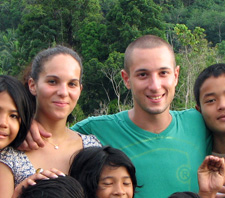 Jeremy and Audrey (France) wanted to spend time with local people and contribute their talents to a worthwhile cause. They found that opportunity through Andaman Discoveries’ newest long-term volunteering program at a southern Thailand orphanage.
Jeremy and Audrey (France) wanted to spend time with local people and contribute their talents to a worthwhile cause. They found that opportunity through Andaman Discoveries’ newest long-term volunteering program at a southern Thailand orphanage.During their nine days at the orphanage, Jeremy and Audrey taught the children fun activities like juggling, and also assisted them with gardening, handicrafts, cooking, drawing, and various construction projects. They discovered that even simple acts like smiling and eating with the children provided companionship and support. “The eldest children are really independent, so most of the time we were with the younger ones. They like drawing, singing and listening to us read story books. The children were always ready and happy to do things with us.”
The couple concluded that “it was a wonderful experience. Thank you to Andaman Discoveries for introducing us to the orphanage. We encourage everybody to do the same.” You can learn more about this new program on our website, or contact us for details.
Labels: orphanage, Thailand, tsunami, volunteer, volunteering
Subscribe to Posts [Atom]

